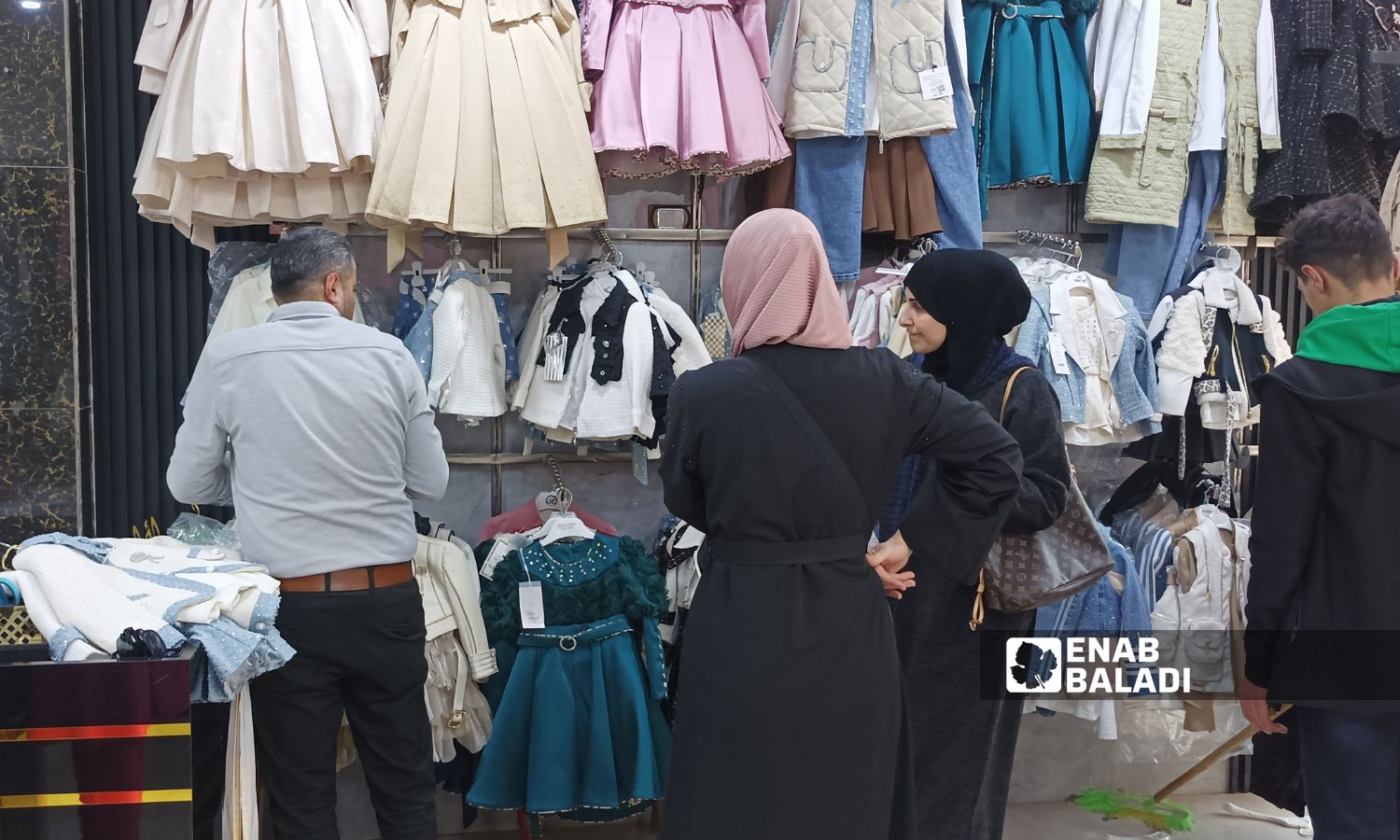After persistent requests from her four daughters to shop and buy clothes for Eid al-Fitr, Heba roamed the markets of Idlib city, as Eid is approaching, and children’s joy isn’t complete without new outfits. However, her calculations and financial ability did not align with the rising prices.
After some effort to find something suitable, Heba bought a girls’ pair of pants from one of the street vendors for 140 Turkish liras (equivalent to $3.5), a cotton sweater for 200 Turkish liras ($5), and a dress for her little daughter for 400 Turkish liras ($10).
She found the prices high compared to the living and economic conditions in Idlib, where daily labor wages do not exceed 150 Turkish liras, job opportunities are scarce, and the needs for Ramadan and Eid are many.
Idlib city is preparing for Eid al-Fitr this year with a wide variety of goods after becoming a focal point for all provinces following the fall of the former Syrian regime, with traders striving to meet the desires of local residents and visitors. However, this diversity and the influx of goods from other provinces have been accompanied by rising prices.
High prices
Most of the families interviewed by Enab Baladi in the markets expressed shock at the high prices. They had hoped that after market openings and the availability of multiple resources, they would experience a decrease in clothing prices, like other provinces, but the opposite happened.
Rania al-Deiri, a mother of three children, told Enab Baladi that most major shops in Idlib price items in dollars, and with the fluctuating Turkish lira and its unstable exchange rate, prices can change overnight, adding an extra burden on families, as she stated.
She added that her husband sells vegetables at a street stall, and his daily wage does not exceed 300 Turkish liras. Yet, he wants to buy new clothes for their children to bring joy to their hearts.
According to Enab Baladi‘s observations, the price of a medium-quality boys’ pair of pants reached 240 Turkish liras, cotton sweaters ranged from 450 to 800 Turkish liras, depending on quality and size, men’s pants ranged from 400 to 800 Turkish liras, and shirts ranged from 280 to 600 Turkish liras.
As for sets of girls’ or boys’ clothing, prices range from 1300 to 2400 Turkish liras (between $35 and $60), which are prices suited to a small, higher-income segment of the community in Idlib.
A men’s clothing shop owner in Idlib justified the high prices by the increasing rents of the shops. He pays 500 dollars monthly to the landlord, and some traders tend to import Turkish clothes, which imposes customs fees on them. Prices have also risen due to the depreciation of the Turkish currency.
Clothing prices for Eid in Idlib have increased by 20% compared to 2024 – March 28, 2025 (Enab Baladi/Samah Alloush)
Second-hand clothing is not cheaper
The majority of families have turned to mobile markets that circulate between neighborhoods on specific days for each area, or to street vendors that spread out during the last ten days of Ramadan in most markets of the city.
However, second-hand clothing (bale) has ceased to be a refuge for low-income individuals due to imposed customs duties and rising prices, forcing most sellers to liquidate their remaining stock and search for other work, according to Mohammed, a former second-hand clothing vendor who has turned his work to selling household textiles.
The presence of “bale” is limited to some major stores that sell it at prices close to new items, claiming they are European, clean, and of high quality, but demand for them is moderate, as Enab Baladi observed.
For second-hand clothing, the price of women’s pants reached 320 Turkish liras, women’s abayas 600 Turkish liras, and children’s clothing ranges from 120 to 600 Turkish liras, depending on quality and fabric. During holidays, demand for second-hand items is weak since most families prefer to buy new clothing.
Mrs. Feryal al-Agha stated that she bought good quality fabric for her daughter at a price of 400 Turkish liras, and she placed it with a woman in her neighborhood who sews dresses according to her requests for a fee of 400 Turkish liras. Thus, the total cost comes to about 800 liras, a price that cannot be found in the markets for the same quality, as she expressed.
Crowding in Idlib markets before Eid al-Fitr – March 28, 2025 (Enab Baladi/Samah Alloush)
20% increase from 2024
With the weather fluctuating between sunny and relatively cool, families are puzzled about the best purchases, as the goods available in the markets vary between summer, spring, and winter wear. According to Malek Suleiman, a clothing shop owner, most customers at the start of Ramadan bought winter clothing, but with rising temperatures, customers began requesting cotton clothes with long sleeves suitable for the spring weather in April.
Regarding demand, he described it as moderate compared to 2024. Prices have risen by approximately 20%, as he used to sell larger quantities than this year. He attributed this to many displaced people choosing to go back to their towns during the last ten days of Ramadan to spend the holiday there and buy what they need from there, including clothing and sweets.
According to the United Nations Development Program (UNDP), nine out of ten people in Syria live in poverty, with the poverty rate tripling from about 33% before 2011 to 90% by 2025. Extreme poverty has also increased sixfold, from 11% to 66%.
Eid clothing prices rise in Idlib: Predominantly priced in dollars Enab Baladi.
Read More Details
Finally We wish PressBee provided you with enough information of ( Eid clothing prices rise in Idlib: Predominantly priced in dollars )
Also on site :
- Cano Health Announces Eric Jenkins as Chief Executive Officer
- Macy’s is starting to close 66 stores across the country. See the full closure list
- African workers are taking on Meta and the world should pay attention

